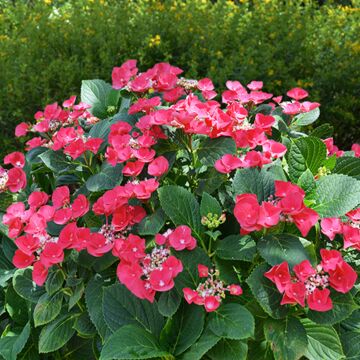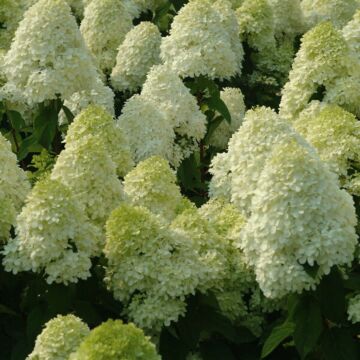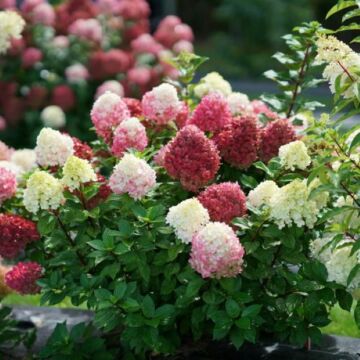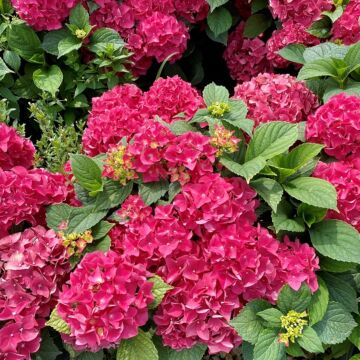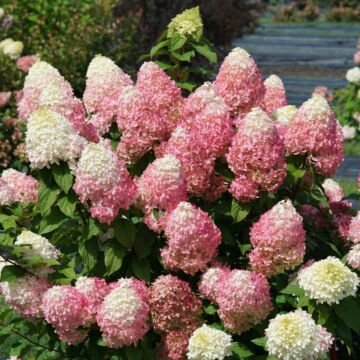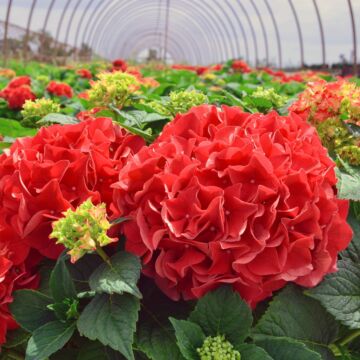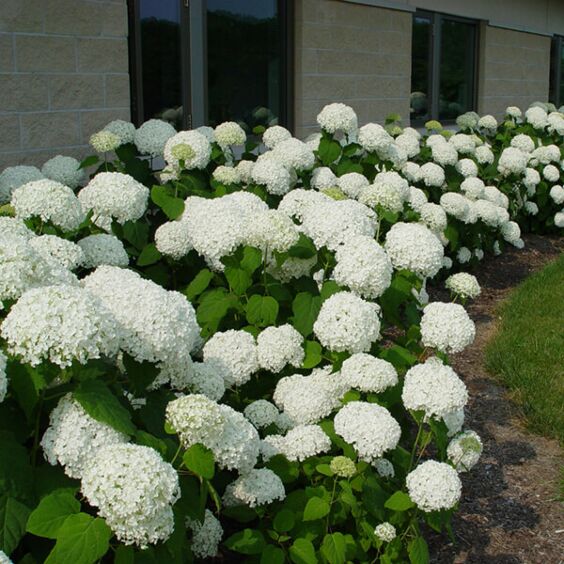
Growing zones
See Zone Map >Status: In stock
Please note: #5 containers cannot be shipped to Arizona, California, Idaho, Montana, Nevada, Oregon, Utah, or Washington due to size restrictions.
- Sun, Part Sun/Shade, Shade
Mature Plant Size (H x W): 3-5' x 3-5'
Bloom Season: Summer, Fall
- Salt Tolerant
- Long Blooming
- Award Winning
- Walnut Toxicity Resistant
- Cut Flower
- Attracts Pollinators
Planting & Care for Annabelle Hydrangea Shrubs
Preparation
- Annabelle Hydrangea shrubs need damp soil high in organic matter.
- Improve poor soil areas by digging in plenty of well-decayed manure or compost a few months ahead of planting.
- Japanese beetles do not appear to like this particular smooth hydrangea species.
It’s cold-tolerant as its blooms last through summer, fall, and winter. - Annabelle Hydrangeas can be planted from March to November.
- Pick a spot that has dappled sunlight or morning sun and afternoon shade.
- Make sure they are sheltered from frosty winds, which will damage blossoms.
- A mature Annabelle Hydrangea can grow to be 3-5' tall by 3-5' wide.
- You can cut back your plant in early spring if needed for size control or better shaping.
Opening Plant Material
- Bare Root: Cut open the bundle (top and roots are tied) and separate all the plants. Soak roots in buckets of water until planted. Each plant type will be labeled separately for identification. Keep the roots from full sun since they should never dry out. Keep roots covered. All bare-root plants must be trimmed when planted.
- Containers: Completely saturate all container plants by putting them in a larger water container until bubbling stops. Remove the plant, then dig a hole no deeper than the depth of the container, ensuring it’s wider on the sides by an additional 6” or more.
Planting Bare Root
- Dig a hole at least 6" wider and the same depth as the root mass. The crown or graft of the plant should be slightly higher than the ground level where it was grown at the nursery.
- Trim off the broken roots and branches.
- Place fertilizer packets in the hole (if purchased). Do not place other fertilizers in the planting hole. *Use Our Recommended Fertilizer.
- Spread the roots and fill halfway with soil, then water until the soil settles completely, saturating the soil and planting pit.
- Re-adjust the plant and fill the hole with the rest of the soil.
- Backfill the balance of the soil and water well.
Planting Containers
- Annabelle Hydrangeas can be planted in March-November
- Dig a hole no deeper than the depth of the container and 6" or wider on the sides.
Slide the plant from the pot by tapping on the bottom of the pot. - With a shovel or knife, trim the bottom 2" off the root ball for plants in plastic containers.
- Rotate the plant to the proper position. Never lift or move plants by the tops.
Place the root ball in the hole. - Adjust the plant height so the root crown is slightly higher than the ground.
- Notice where the base of the trunk flares out from the tree. This is called the root flare. This root flare should show when the tree is planted. Add soil under the ball so the root flare is exposed if necessary.
- Place fertilizer packets into the bottom of the hole (if purchased). *Use Our Recommended Fertilizer.
- Backfill the hole with soil, ensuring the top of the root ball is visible and slightly higher than the soil around it.
- Firm the soil around the plant. Water well to settle soil around the root ball.
Water frequently when newly planted to conserve moisture, especially in early to late summer.
Pruning - After Planting
- Bare Root: Prune ALL bare root plants to reduce transplant shock and ensure successful planting. Pruning should occur as soon as possible, before or after planting, and with sharp pruning shears.
- Containers: Although it’s not essential after planting, light pruning can improve an Annabelle Hydrangea’s shape. Doing so removes any broken branches from shipping or thins out a heavily branched plant to help in the transplanting process and the appearance of your new planting.
Pruning - Through-out the Season
- Follow these pruning tips for your specific type of hydrangea:
- Hydrangea macrophylla - Cut off spent flowers in spring and remove crowding shoots.
- Hydrangea paniculata – Prune stems to within two buds of the base in late March.
- Hydrangea petiolaris – Cut out unwanted shoots when flowers fade. Remove a third of older stems in spring.
Watering - After Planting
- Plants typically take approximately 6 weeks to establish new roots in your soil. During this period, water plants as often as every 2-4 days at the start and at least a minimum of once per week.
- Beyond the 6-week establishment period, water once per week unless rains occur.
- Remember to check soil moisture by sticking your finger into the soil around 3”.
Watering - Through-out the Season
- After the first season, plants should only be watered during extended periods without rain.
- How do you know if your plants need water? The easiest way to tell is to touch the soil around the roots. If it is moist, there is no need to water. If it’s dry, give it a good soak with the hose end (no nozzle), watering the soil only, not the leaves.
- Same as after planting, stick your finger into the soil around 3” to check soil moisture.
Frequently Asked Questions
How can I protect my Annabelle Hydrangea from harsh winter conditions?
To protect Annabelle Hydrangeas during winter, it’s important to ensure proper care before the onset of cold weather. Similar to caring for other hydrangeas, mulching around the base with organic material such as leaves, straw, or wood chips can help insulate the roots from freezing temperatures. Wrapping the plant in burlap can also provide a barrier against wind and frost. Avoid pruning in the fall as the stems can provide extra protection.
What are some companion plants that thrive well with Annabelle Hydrangeas?
Annabelle Hydrangea is a wild hydrangea that does well with various companion plants that enjoy similar light and soil conditions. Hostas and ferns are excellent choices as they also thrive in partial shade and add texture contrast. Astilbe varieties provide beautiful, feathery flowers that complement the vibrance of Hydrangea arborescens blooms. For a continuous bloom cycle, consider incorporating daylilies, which bring a splash of color when the hydrangeas are not in peak bloom.
Is it possible to grow Annabelle Hydrangeas in containers?
Yes, Annabelle Hydrangeas can be successfully grown in containers. Choose a large pot with adequate drainage holes to accommodate the root system and allow growth. Use a high-quality potting mix that retains moisture yet drains well to avoid waterlogging. Container planting requires careful watering, especially in hot weather, and periodic fertilization to replenish nutrients. It’s also crucial to place the container in a spot that receives morning sunlight and afternoon shade to prevent overheating.
How do you manage pests attracted to Annabelle Hydrangeas?
Regular inspection of plants for early signs of aphids, mites, and beetles is crucial. Introducing beneficial insects like ladybugs or using horticultural oils can effectively control minor infestations without harming the plant. Keeping the area around the hydrangeas clean and free from plant debris also reduces pest habitats. For severe pest problems, applying insecticidal soap or neem oil can help eradicate pests.
Are Annabelle Hydrangeas suitable for urban gardens?
Annabelle Hydrangeas are pretty suitable for urban gardens due to their adaptable nature and compact size. These hydrangeas thrive in partial shade, making them ideal for gardens with limited direct sunlight, which is common in urban environments. Their vibrant blooms add significant aesthetic value to small spaces and balconies. Additionally, their ability to grow well in containers makes them versatile for various urban settings, allowing for mobility and easy adjustment to different spaces within an urban garden.
Enhance Your Green Space With McKay Nursery
At McKay Nursery, we bring over a century of horticultural mastery to your garden with our meticulously selected plant varieties, including the beloved Annabelle Hydrangea. Located in the heart of Waterloo, Wisconsin, we are dedicated to raising hardy and thriving plants to transform your landscape.
When you choose McKay Nursery, you are assured of premium quality plants, each can be backed by our comprehensive warranty and delivered in exceptional packaging to ensure they arrive in pristine condition.
Order our white Hydrangea Annabelle plants today! For expert advice or further assistance, contact us at [email protected] or call 920-478-2121. Let us help you bring your garden dreams to life!
Planting & Handling Help
Download our Planting and Handling Guide below to plan for a successful arrival and install of your plants. Be sure to water all plants as soon as they arrive and every day until you’re ready to plant. Keep any bare root bundles in a shady, cool spot with the roots covered at all times.


Learn More
Watch our videos on handling bare root plants, how your order is prepared for shipment and more.


Plant Sizing
What is the difference between Containers, Grow Bags, Bare Root, and Balled & Burlap (B&B)?
Shipping Times


Our FedEx and local shipping times depend on two factors, one is by the region and the second is the type of product being shipped. For example, small fruits are only shipped in spring, but majority of our perennials are shipped from spring until fall. Keep in mind the dates below act as a general guide. Due to unpredictable weather, staffing, inventory and industry demands these timelines can change. Therefore, we cannot guarantee any of these times.
Shipping Dates by Region*
Northern Cold Region: April 22nd - November 7th
Northern Region: April 15th - November 7th
Middle Region: April 1st - November 7th
Southern Region: March 15th - November 7th
Local Delivery (small radius from Waterloo, WI): April 22nd - November 7th
Shipping Dates by Season*
Spring Shipping: Region Start Date (above) - May
Fall Shipping: September - November
Due to unpredictable weather, these times may vary. Some varieties are exceptions due to heat and plant health reasons. Enter your shipping zip code at the top of this page and be sure to check the shipping information on each product before you add it to your cart. If the product is too large or restricted in your state, you will not be able to checkout with that item in your cart.

